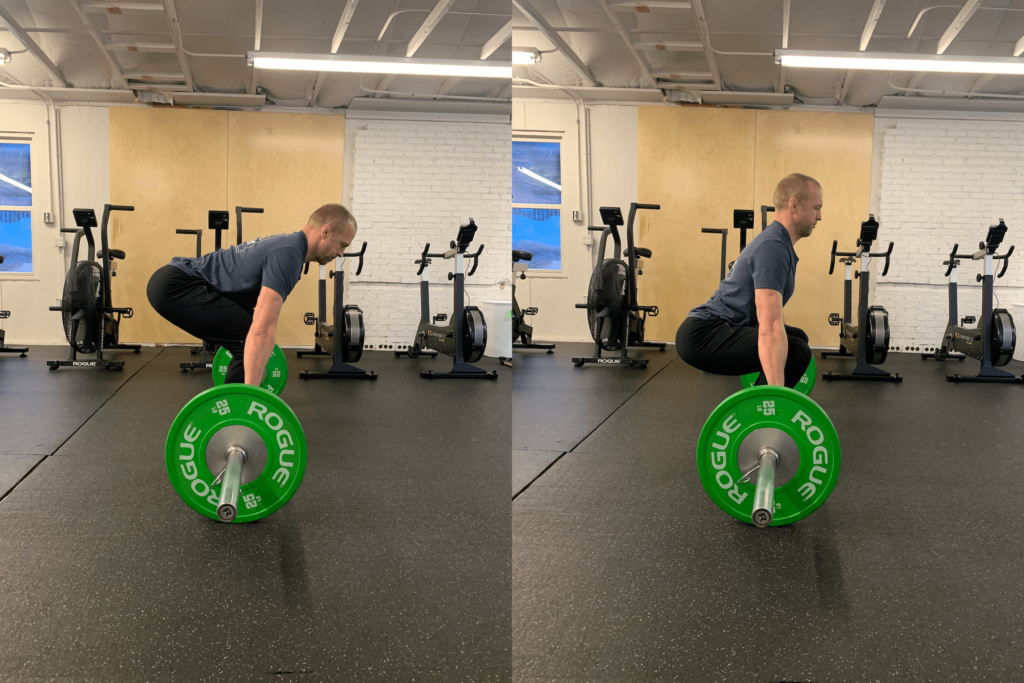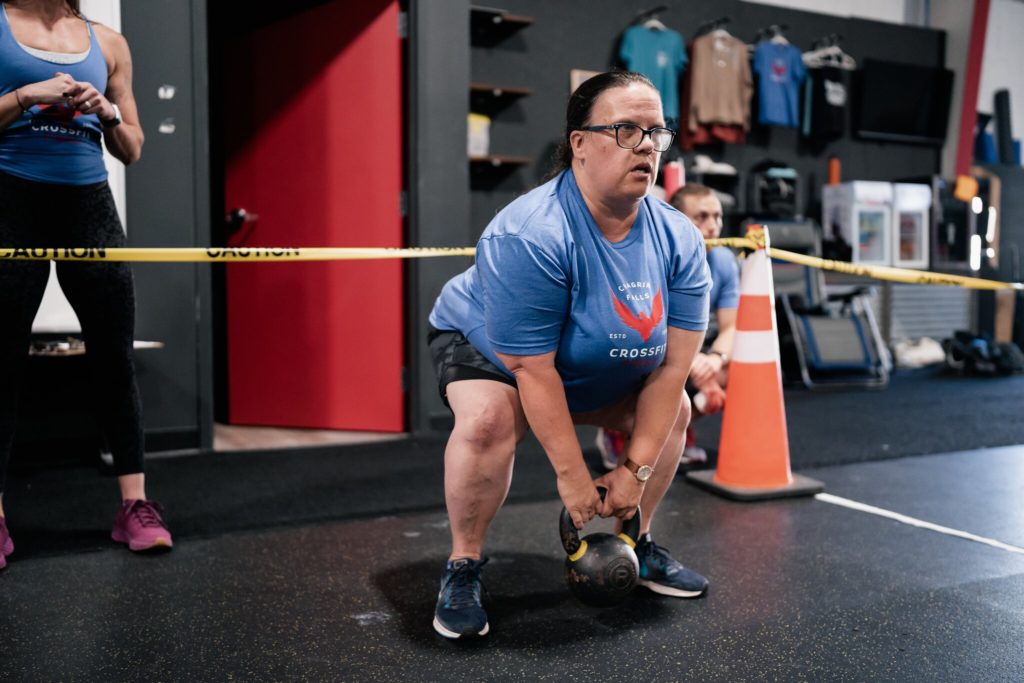The deadlift is one of CrossFit’s foundational movements and is the safe and sound approach by which any object should be lifted from the ground. It is unrivaled in its simplicity and impact while unique in its capacity for increasing head-to-toe strength.
The deadlift can be commonly seen in many everyday activities like lifting a grocery bag or picking up a child. Maintaining functionality in this hip-hinging movement is key to lifelong fitness, which is the definition of health.
In an athlete’s pursuit of fitness, getting stronger in the deadlift offers a “quick boost of general strength and sense of power.” As the initiation of Olympic lifts such as the snatch and the clean and jerk, and the safe way to lift anything off the ground, the deadlift is essential in optimizing fitness and safely performing everyday tasks.
CrossFit recommends deadlifting at near-max loads once per week or so and maybe one other time at loads that would be insignificant at low reps. Be patient and learn to celebrate small, infrequent bests.
How Do I Deadlift With Proper Form?

While the deadlift may seem simple, essential points of performance must be abided by in order to perform the movement in the safest and most efficient and effective way possible. The first thing to consider is the setup position, which will vary based on leg and torso length.
When setting up for the deadlift:
- The feet should be somewhere between the hips and shoulders.
- The bar starts at mid-shin with the athlete gripping the bar outside the shins and the bar in contact with the body.
- The shoulders are higher than hips, and the hips should be higher than the knees. This may change based on the height of the athlete. A taller athlete will have less incline between shoulders and hips in the setup.
- The back should be braced and in a neutral position. This will translate to a rigid torso and no movement between the hips and shoulders through the lift.
- Shoulders and hips rise at the same time when initiating the lift.
- Bar stays in contact with the body throughout the lift.
- Drive through the heels on the initial pull as the knees move back and the chest lifts in unison.
- To reset, retrace the same path on the way down, pushing the hips back and regaining the rigid neutral position of the torso. Once the bar has crossed the plane of the knees, the knees rebend and the bar returns to the starting position.
How Should I Grip the Bar in a Deadlift?
In the deadlift, use a symmetrical grip whether parallel, hook, or alternate. With your feet in a hip-width stance, the hands should be placed just outside the shins where the arms will not interfere with the legs while pulling from the ground.
We recommend using a double overhand parallel grip as long as possible to develop grip strength and potentially transference to other movements that require a similar grip (toes-to-bars, pull-ups, etc.)

From left to right: 1. the hook grip, with the thumb wrapped around the bar and the fingers then wrapped over the thumb, 2. the alternate grip, with one hand palm up and one hand palm down, and 3. the double overhand grip, with both palms down (hook grip still recommended)
The alternate grip is more secure and appropriate at maximum loads because as the bar is rotating out of one hand, it is rotating into the other. This grip should be experimented with at light loads if you plan to utilize it at near-maximum loads. It should be noted that this grip is not necessarily recommended for beginners still developing baseline levels of grip strength.
The hook grip is a non-negotiable grip for the Olympic lifts such as the snatch and the clean, and while it is a bit stronger of a grip than the traditional parallel grip and can be practiced while performing deadlifts, it may be uncomfortable.
Experiment and work regularly with alternate, parallel, and hook grips. Explore variances in stance, grip width, and even plate diameter carefully and cautiously — each variant uniquely stresses the margins of an all-important functional movement.
Which Muscles Are Worked in the Deadlift?
A well-executed deadlift is truly a full-body exercise that works the muscles throughout the entire body. With that said, the targeted areas are the muscles of the posterior chain (glutes, hamstrings, spinal erectors). Additionally, a braced core is an essential component of a sound deadlift. The core (abdominals, obliques, and spinal erectors) are taxed heavily to maintain a stable trunk throughout the movement. The deadlift is a potent way to work your core when lifting heavy loads. The lats and upper back are also utilized to keep the bar tight to the body and the shoulders active.
What Are the Benefits of Doing Deadlifts?
The deadlift is an effective path to increased hip capacity. Regardless of whether your fitness goals are to “rev up” your metabolism, increase strength or lean body mass, decrease body fat, rehabilitate your back, improve athletic performance, or maintain functional independence as a senior, the deadlift is a marked shortcut to that end.
In its most advanced application, the deadlift is prerequisite to, and a component of, “the world’s fastest lift,” the snatch, and “the world’s most powerful lift,” the clean, but it is also, quite simply, no more than the safe and sound approach by which any object should be lifted from the ground.
The deadlift’s primal functionality, whole-body nature, and mechanical advantage with large loads suggest its strong neuroendocrine impact, and for most athletes, the deadlift delivers such a quick boost in general strength and sense of power that its benefits are easily understood. If you want to get stronger, improve your deadlift. Driving your deadlift up can nudge your other lifts upward, especially the Olympic lifts.
What Are Common Flaws in the Deadlift?
While some fear the deadlift, attention to proper setup and execution will alleviate any hesitation you have toward this highly functional, inherently safe movement. Just like we focus on the setup first in the points of performance, we use the same sequence when calling out common flaws.

Left: proper deadlift setup, Right: hips too low
One of the most common flaws in the deadlift is starting with the hips too high or too low in the setup. “If the initial setup position of the deadlift is incorrect, it will be very difficult to correct anything that happens after that.”
Timing is also key. As the lifter begins the lift, the knees should extend as the chest lifts — a common flaw. is driving the knees back without lifting the chest, resulting in a straight-leg deadlift (a valuable tool, but a deviation from the traditional deadlift).

Neutral spine (left) vs. loss of neutral spine (right)
The opposite is also true — lifting the chest without pulling the knees back results in the bar moving in an arced pattern around the knees rather than in a nice straight line up the body.
The most egregious flaw to be aware of is any change in the neutral-spine position.
The spine remaining neutral and braced throughout this lift ensures the safety of our spine and therefore should be non-negotiable.”
Athletes should only lift loads that allow them to maintain a neutral spine throughout the lift.
What Are the Different Variations of the Deadlift?
Deadlifts can be done with various implements. Though traditionally practiced with a barbell, deadlifts with dumbbells, kettlebells, and even water jugs can produce the same benefit.
An athlete can also adjust their stance in the traditional deadlift, bringing their grip inside their knees and their feet wide — this is called a sumo deadlift.

Athlete performing a kettlebell deadlift
The Sumo Deadlift
The sumo deadlift is a variation of the traditional deadlift, and the two movements share many similarities: Both stress midline stabilization, posterior-chain engagement, and balance about the frontal plane. However, the wider stance and grip inside the knees facilitate a more upright pulling position, a shorter range of motion, and greater reliance on the quadriceps than the conventional deadlift. Additionally, the sumo deadlift greatly mimics the ways we lift things in day-to-day life and can help athletes learn the proper position for a conventional deadlift if that is something that challenges them.
Other Hip-Hinging Movements
The GHD Hip Extension
The Kettlebell Swing
The Back Scale
The Box Jump
Comments on What Is a Deadlift?
Pro tip: For effective muscle recovery in CrossFit, it's essential to focus on post-workout care, including stretching, hydration, and proper nutrition. We give some advices here : https://www.recupmuscle.fr/recuperation-apres-une-seance-de-crossfit-methodes-efficaces/
The deadlift is really effective for sports like rugby. We use it regularly in our physical preparations before a rugby season. If you want to go further, you can view all of our rugby advice on : https://rueil-rugby.fr/
Thank's a lot! The blog post is well-written and informative, and it provides a valuable resource for anyone who is interested in learning more about the deadlift. The author does a good job of explaining the different aspects of the deadlift, and they provide clear and concise instructions on how to perform the exercise.
That's a good lookin' gym!!
What Is a Deadlift?
4